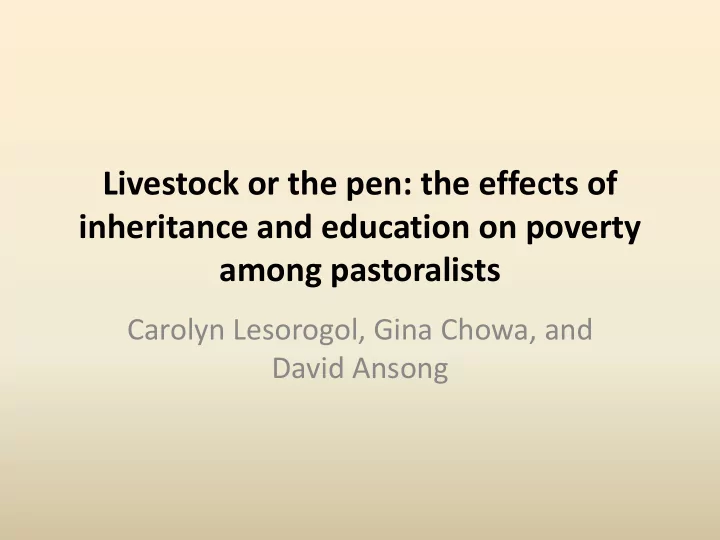

Livestock or the pen: the effects of inheritance and education on poverty among pastoralists Carolyn Lesorogol, Gina Chowa, and David Ansong
The Problem • Poverty among pastoralist livestock herders in Kenya – Persistent drought – Falling per capita livestock holdings – Lag in access to formal education – Few alternatives to pastoralism
Questions • Key questions: – What are the current practices of livestock inheritance and formal education among Samburu pastoralists? (qual interviews) – Is livestock wealth/poverty transmitted intergenerationally in this community? (survey data and regression analysis) – Is formal education associated with increases in wealth and income for this population? (survey data and regression analysis)
Field site: Samburu District Kenya
Methods • In-depth interviews with 16 informants; 4 father-son pairs, 8 individuals – practices of livestock inheritance and perceived affects of inheritance – Decision-making regarding enrolling children in school; attitudes about education • Household survey (n=156; 128 used) – Demographics, income, livestock wealth, education, parental wealth, livestock inheritance
Description of Survey Sample Variables Mean StDev Range Median Mode Dependent Variable Son’s current wealth in TLU 15.93 22.94 0 – 174.24 8.68 0 Independent Variables Father’s wealth in TLU 158.58 426.14 0 – 4036 92.92 0 Inheritance in TLU 19.16 25.76 0 – 144 8.92 0 Income (KES) 99,331.72 104,890.2 0 – 687,800 69,980 16,800 Household size 9.27 3.89 3 – 26 8 7 Age 55.22 12.03 33 – 85 53.90 47 Years of Education 1.95 3.84 0 – 18 0 0 # of Wives Frequency Valid % 0 2 2 1 83 65 2 35 28 3 6 5 4 1 1 Community Siambu 68 53 Mbaringon 60 47 Formal Education Yes 40 32 No 86 68
Findings 1 • Qualitative interviews find: – Inter vivos transfers of livestock significant and help distribute wealth across sons and houses within a household – Post-mortem inheritance limited to eldest sons and entails assumption of father’s role as head of family – History of resistance to formal education giving way to investments in formal education due to perceived benefits to education such as employment, skills, and knowledge
Regression Analysis: Inheritance Ordinary Least Squares Quintiles by Son’s current Wealth Without With Without With interaction interaction Interaction Interaction b (SE) b (SE) b (SE) b (SE) Predictors Inheritance in TLU -.006(.001) .007(.007) -0.011(.009) 0.012(.015) Father’s wealth in .002(.001) .002(.001)* 0.001(.002) 0.004(.002) TLU Covariates Income .000(.000)* .000(.000)* 0.000(.000)* 0.001(.000)* AAME .064(.030)* .092(.032)* 0.130(.066) 0.200(.075)* Age .001(.009) -.001(.009) 0.009(.019) 0.008(.019) Years of Education -.073(.028)* -.063(.028) -.121(.060) -0.102(.061) Interaction -.000(.000)* 0.000(.000)* Model Fit F Statistic 6.635* 6.762* Adjusted R 2 .275 .312 LogLik 263.98 258.94 X 2 24.31* 29.35* Deviance 263.98 258.94 Nagelkerke R 2 .247 .290
Regression Analysis: Education and Income Independent variable Parameter estimate ( b ) t p Years of education 4674.72 2.57 .011 Son’s wealth 2103.06 6.32 .000 AAME -200.85 -.09 .926 Age -5.19 -.01 .993 N =121, F (4,117) = 11.41, p <.0001, Adjusted R 2 =.256
Findings 2 • Quantitative regressions find: – Parental wealth positively associated with son’s wealth — structural advantages of membership in a wealthy family – Amount of livestock inherited not necessarily associated with current wealth – Parental wealth moderates livestock inheritance — inheritance more effective for wealthier than poorer households – Formal education associated with increased income, but not with livestock wealth
Limitations • Cross-sectional, not longitudinal design • Small sample size • Not having father-son pairs in the survey sample • Measurement of income
Policy Implications • Given increase in educational investments by households, more attention should be paid to educational access, quality, and opportunities following education • Risk and uncertainty in the environment lead to instability in livestock holdings, so policies should seek to mitigate risks in appropriate ways.
Recommend
More recommend